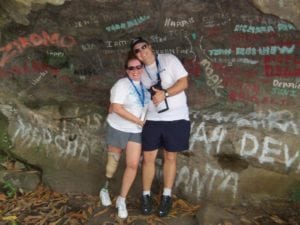By Emily Dings
Although each amputee’s experience is unique, the period following any amputation involves an inevitable amount of adjustment. The mental shift toward accepting the loss of a body part can be as difficult as the physical shift to performing daily activities in a new way. Unfortunately, this experience can also lead to loneliness and isolation, even for those with strong support systems.
“Historically, loneliness was conceptualized as a social problem,” says Laurie Theeke, associate professor at West Virginia University (WVU) Schools of Nursing and Medicine and family nurse practitioner at the WVU Clark K. Sleeth Family Medicine Clinic. Theeke’s research focuses on the impact of loneliness on physical and psychological health. More recently, she notes, researchers have found that “loneliness is really a multifaceted biopsychosocial stressor,” and spending time among friends and family is not always enough to prevent it. “People need to meet their needs for love and belonging through mutuality in relationships and high self-value along with social integration to avoid loneliness,” she adds.
Erin Deegan was only 13 when she lost her leg to cancer and had to grapple with feelings of loneliness earlier than most. Although she had previously been active in track, gymnastics, and dance, following her surgery she was most frustrated by being unable to share in everyday fun with other neighborhood kids. Activities she had taken for granted, such as climbing trees and walking through the woods, now seemed unattainable.

“The first thing to remember is that you will be able to do things eventually,” Deegan says, remembering the day she found a walking stick in the woods that let her take a few tentative steps. She recommends making these kinds of small, reachable goals, knowing that you’ll be able to do more in the future. Don’t be afraid to ask for help when you need to walk more slowly or grab a friend’s arm for stability, she adds. “Get outside of the head space that asking for help makes you helpless.”
Deegan emphasizes that while social media from prosthetics companies and Paralympians can be inspiring, for amputees with modest goals, it can also lead to feelings of inadequacy that can stop them from getting out and doing things.
“You don’t have to be an athlete to be active,” Deegan says. “Taking a walk at a park or dancing like a silly weirdo is enough to be active.” If reading a blog post from an amputee marathoner is making you feel bad, she counsels, turn off the computer and remember that “you can do lots of things that they can’t.”
Kathie Ewers remembers the depression that followed having her leg amputated after a motorcycle accident. Her injuries were so severe that she needed nine separate surgeries and couldn’t be fitted for a prosthetic leg for over six months. An active, outdoorsy mother and teacher, Ewers struggled with feelings that life as she knew it was over.
“I thought I would be stuck in a wheelchair my whole life…. I thought I would lose my family and friends. I was wrong on all of those [counts],” she says.
Even though her family, friends, and students had been supportive from the beginning, it took a year of physical and emotional healing for Ewers to believe that she wouldn’t have to give up the pastimes she loved.
“Any time I said I couldn’t do something, they said, ‘Why not?’” At first, Ewers felt self-conscious about even routine activities such as going out to dinner. She worried that people would stare at her amputated leg, so her family helped her put on her prosthesis before entering a restaurant. Gradually her “why nots” became more daring, as she found herself boating, swimming, and hiking again. On her first post-surgery boat trip, she learned that she could board the boat by sitting on a picnic table bench, using her arms to move up to the table, and having a friend lift her up. “We brainstormed together and found a way.”
While it might be scary for some amputees to venture outside using a prosthesis, crutches, or a wheelchair, once you find ways to do so safely and successfully, you will probably enjoy going out again.

Tom Stiles has become an expert at finding a way. Formerly a club-level tournament tennis player, contracting meningococcemia at age 34 when working overseas had not been a part of his plan. Stiles lost both his feet and struggled with the realization that he would no longer be able to be competitive at tennis.
Seeing a brochure about the National Amputee Golf Association (NAGA) at his prosthetist’s office was a revelation. Stiles began playing in national and regional tournaments each year, enjoying them as much for the fellowship as for the athleticism. “It’s hard to find a happier group of people,” he says. “Whether they are shooting 70 or 120, they are so happy just to be out on a golf course.”
Now the director of the Southwest Amputee Golf Association (SWAGA), Stiles reflects that he can do almost anything he sets his mind to, including playing numerous sports. He emphasizes the importance of recognizing the capability of the body you’re in. For example, he was never tall enough to be a professional basketball player even before the amputation, yet this quality had never made him feel limited. He recalls seeing a regional tournament golfer who was missing a leg and on crutches hit a ball out of a sand trap using one hand. “If a guy can do that, he can do anything!” Stiles says.



